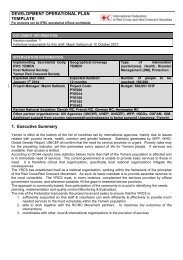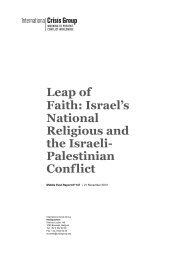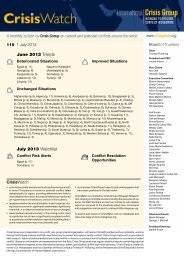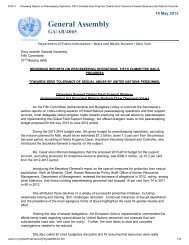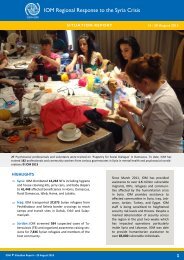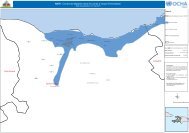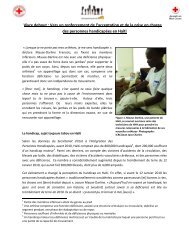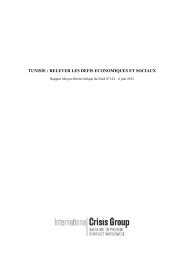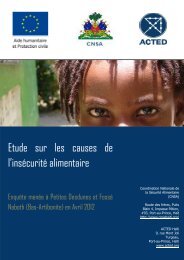SOMALI NUTRITION STRATEGY 2011 – 2013 - ReliefWeb
SOMALI NUTRITION STRATEGY 2011 – 2013 - ReliefWeb
SOMALI NUTRITION STRATEGY 2011 – 2013 - ReliefWeb
Create successful ePaper yourself
Turn your PDF publications into a flip-book with our unique Google optimized e-Paper software.
46<br />
Regarding iodine, interestingly, the survey found high urinary iodine concentrations in all groups.<br />
The reasons for this are not clear at this stage and will be subject to further investigation. Possible<br />
reasons include dehydration of subjects or high iodine content of water but do not include high<br />
intakes of iodised salt as overall use of iodised salt was found to be very low at 3.9% (0.4% in the<br />
Somaliland, 0.15 in Puntland and 6.7% in South Central Somalia. The prevalence of visible goitre<br />
among women was significant in Somaliland at 3.3% compared to 1.4% in South Central Somalia.<br />
This indicator was not investigated in Puntland. Goitre can be due to excessive or inadequate<br />
intake of iodine.<br />
3. Determinants of Malnutrition in Somalia<br />
Malnutrition results from a complex set of factors and not one simple cause. The UNICEF<br />
conceptual model of the causes of malnutrition (see figure 8 below) provides a useful framework<br />
for the discussion of determinants of malnutrition in Somalia. The volatile political situation and its<br />
resulting insecurity, civil unrest or outright war have led to a chronic and continuing humanitarian<br />
crisis that is at the root of the high prevalence of malnutrition in Somalia. However, even in years of<br />
relative stability and improved food production, the malnutrition rates in some regions of Somalia<br />
have remained consistently high, providing evidence for the contribution of underlying causes.<br />
3.1 Food security (Food access and availability)<br />
Somalia is chronically food insecure. Overall, around 80% of Somali households rely on natural<br />
resource-dependent activities for their livelihood, making them highly vulnerable to environmental<br />
factors and shocks. Even in good years, Somalia is only able to produce 40% of its cereal<br />
requirements. In the last five years, local production has averaged about 30% of food needs. (ref<br />
WFP website). Somalia was a major recipient of international food aid even before the collapse<br />
of central government in 1991.<br />
Food security varies wildly by area, season and according to climatic, political and economic<br />
factors (openness of cross border markets and internal urban markets). Traditionally, the sedentary<br />
farmers of the Juba valley and around Baidoa have suffered the most acute and long lasting<br />
nutritional crisis. In comparison the pastoralists have fared best as their mobile, cattle based<br />
strategy is flexible and adaptive to the stresses of conflict and insecurity. Pastoralists rely on the<br />
consumption and sale of milk and animal products for their livelihoods. Livestock milk availability<br />
and consumption has a very significant influence over the nutritional status of the pastoralist<br />
population as shown by a case study from West Golis/Guban livelihood zone described in the<br />
FSNAU Post Gu 2009 assessment. This shows that once availability of milk declines eg due to loss<br />
of livestock resulting from disease outbreak and or drought conditions, rates of acute malnutrition<br />
deteriorate to very critical levels but improve again once the livestock situation recovers and<br />
availability of milk increases. As discussed in the case study this demonstrates the natural ability<br />
to recover from shocks provided that they are not recurrent and cumulative.<br />
According to FEWS Net, underlying causes of food insecurity in the country are the following:<br />
• Successive seasons of poor rains and seasonal flood affected crop and livestock production,<br />
which are the two main livelihood sources for the majority of the rural population.<br />
• Recurrent conflict and civil insecurity, which have resulted in civilian displacement and<br />
restriction of internal and cross border trade flow.<br />
• Chronic macroeconomic shocks, such as the persistent ban of livestock export and lack of<br />
employment opportunities, affected investment in productive sectors like crop and livestock.<br />
Results of the most recently conducted FSNAU led multi-agency post deyr ‘09/10 seasonal<br />
assessment indicate some improvement in the overall food security situation in country, especially<br />
in rural areas of the south where crop and livestock production has improved following normal<br />
deyr rains. However, although the number of people estimated to be in need of emergency




